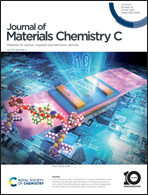Atomically dispersed Ru supported on microporous CoO ultrathin nanosheets synthesized by melamine induction for a highly efficient oxygen evolution reaction†
Abstract
Two dimensional materials show unique advantages in catalysis. In this work, it was found that melamine could induce the directional growth of cobalt-based catalysts to form an ultra-thin two-dimensional hexagonal nanosheet structure with only 1.5 nm. In addition, these hexagonal nanosheets (HNs) could grow into a microporous structure under high temperature conditions, and the finally formed CoO hexagonal porous nanosheets (HPNs) had a surface area 11.3 times that of the nanoparticles. Embedding 1.25 wt% of monoatomic ruthenium in the CoO HPNs (CoO/Ru1.25% HPNs) allowed the catalyst to have more active charge storage and transfer centers. The results showed that the overpotential of CoO/Ru1.25% HPNs was 64 mV lower than that of CoO nanoparticles at 10 mA cm−2. The Tafel slope of CoO/Ru1.25% HPNs was only half that of CoO nanoparticles, indicating that a small amount of Ru dispersion and the two-dimensional structure control significantly increased the kinetic rate in the oxygen evolution reaction. The DFT results showed that the Ru single atoms in CoO/Ru HPNs (111) possessed the lowest energy barrier (1.19 eV). The Ru single atoms could effectively reconstruct the neighboring localized structure in the formation of ˙OOH, which desirably decreased the free energy of the system.

- This article is part of the themed collections: 2023 Journal of Materials Chemistry C HOT Papers and #MyFirstJMCC


 Please wait while we load your content...
Please wait while we load your content...